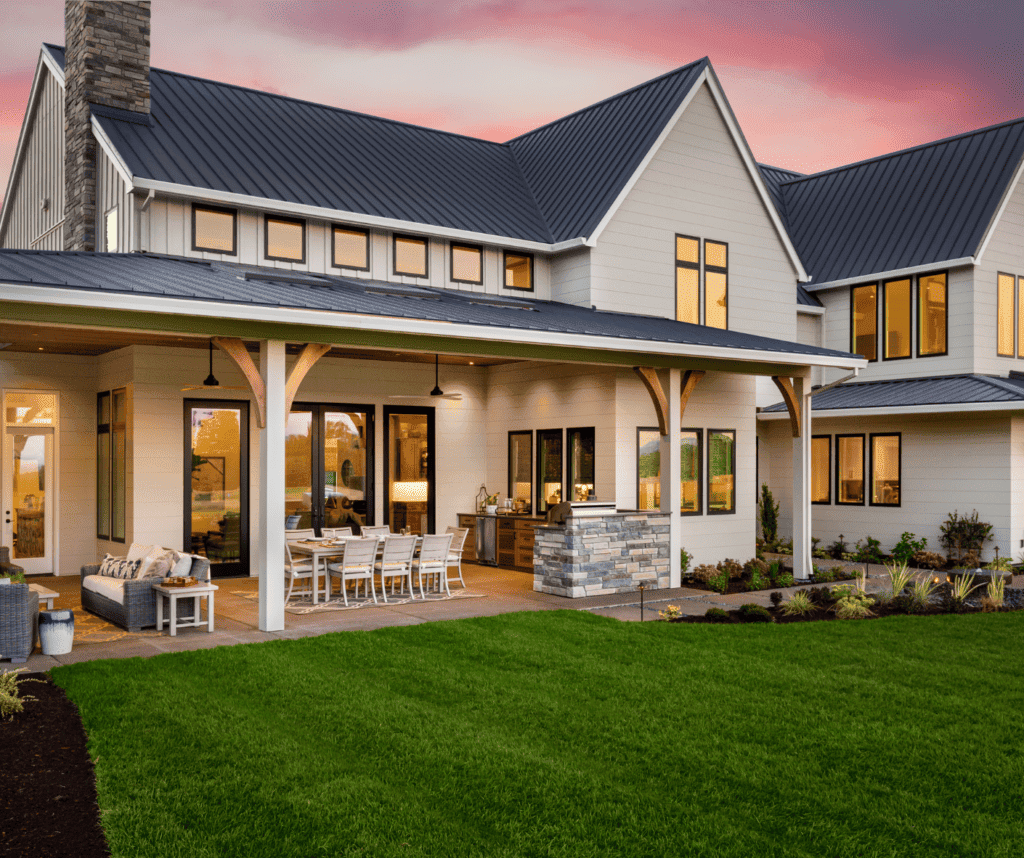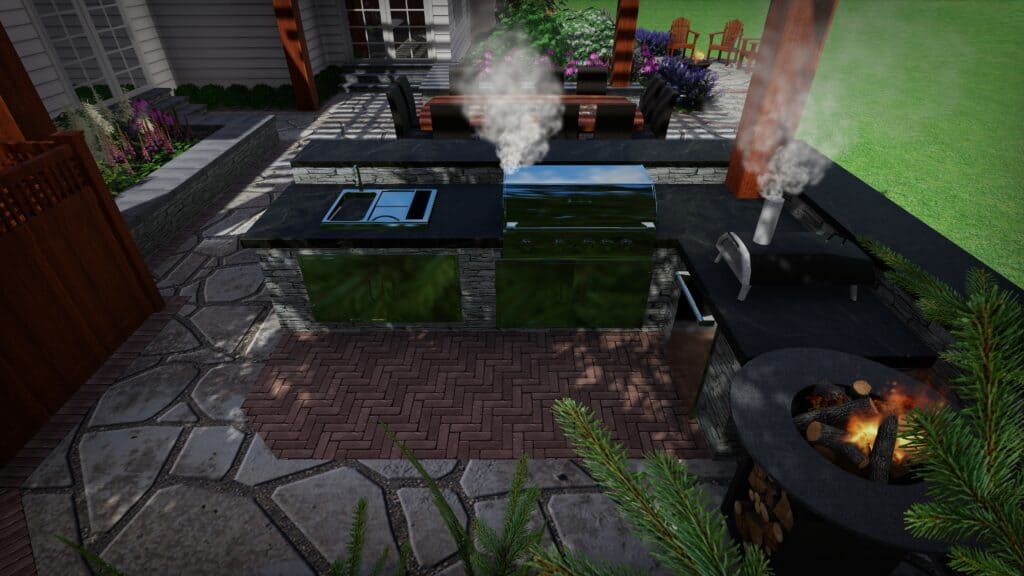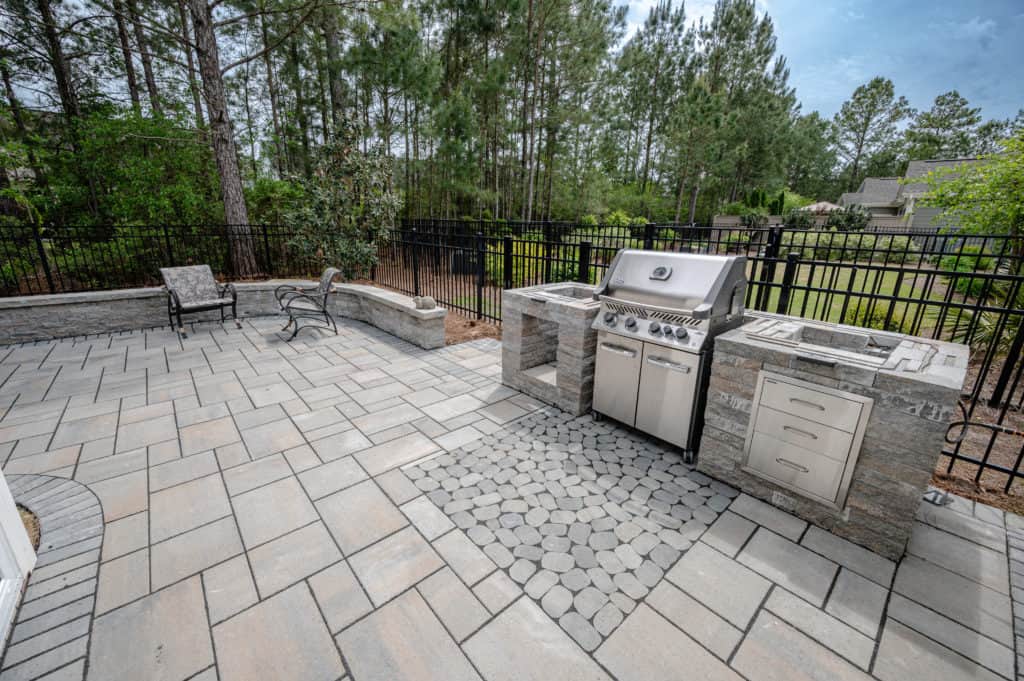Introduction: Why Outdoor Kitchens Are on the Rise — and Why Problems Happen
You’ve been dreaming about it for years: warm evenings, cold drinks, friends gathered around the grill, and that perfect outdoor kitchen space where you can cook, entertain, and relax. Maybe you’ve even saved some Pinterest boards or started sketching ideas. But now that you’re ready to move forward, something’s nagging at you.

What if you mess it up? What if you invest thousands of dollars and it doesn’t turn out how you hoped?
What if it looks great, but it’s not actually usable? Or worse, what if you hire the wrong contractor and end up dealing with constant repairs, safety hazards, or code violations?
You’re not alone. We talk to homeowners every day who are excited but overwhelmed. And the truth is, outdoor kitchens are a big investment, and there are a lot of moving parts—literally and figuratively. If you don’t plan ahead and make smart choices, things can go sideways quickly.
As outdoor living space contractors who’ve built hundreds of outdoor kitchens, we know exactly where projects go wrong. In this article, we’re going to break down the 7 most common issues homeowners face when installing an outdoor kitchen—and more importantly, how to avoid them. You’ll walk away with clarity, confidence, and practical tips that’ll save you time, money, and stress.
1. Poor Planning and Layout Mistakes
Let’s start with the most common (and most expensive) problem: poor planning.
Outdoor kitchens aren’t just about slapping a grill and a mini fridge on the patio. You need to think through how the space will be used, where the appliances should go, and how people will move around the area.
Imagine this: You finish your beautiful new kitchen, but every time you open the fridge, the door bangs into the grill. Or your guest is standing right in your cooking zone while trying to chat. Or you have to walk 15 feet just to wash your hands because the sink is nowhere near your prep area.
These mistakes are frustrating—and totally avoidable with a proper layout.
Quick Tip: Use the classic “kitchen work triangle” rule: keep your grill (cooking), fridge (storage), and sink (cleaning) within a comfortable triangle of movement. It’s not just for indoor kitchens—it works outdoors too!
2. Choosing the Wrong Materials for Your Outdoor Kitchen
It’s easy to get distracted by Pinterest-worthy photos of sleek countertops and trendy finishes. But remember: this kitchen is going to live outside. That means it has to stand up to sun, rain, wind, and possibly snow—depending on where you live.
The materials you choose can make or break your outdoor kitchen in the long run.
Common Mistake: Using indoor materials like marble countertops, MDF cabinets, or regular drywall. These materials might look good at first, but they can warp, rust, crack, or fall apart fast.
Better Choices:
- Countertops: Go for granite, concrete, or outdoor-rated tile.
- Cabinets: Choose stainless steel, marine-grade polymer, or stone veneer.
- Flooring: Pavers, stamped concrete, or natural stone are durable and weather-friendly.
You don’t want to replace your entire setup after one harsh winter.

3. Underestimating Utility Requirements (Gas, Water, Electricity)
This is a big one. You know you need utilities—but many homeowners underestimate how tricky and costly this part can be.
Running gas lines for a grill or pizza oven, installing a water line for a sink, or wiring up lights, outlets, and a fridge—these things require planning, permits, and often licensed professionals.
We’ve seen homeowners run out of budget or end up delaying their build because they didn’t account for the cost of trenching lines or bringing utilities to their backyard.
Quick Example: Let’s say your outdoor kitchen is 50 feet from your house. Running a gas line that far isn’t just a plug-and-play job. It requires digging, safety inspections, and city permits. Costs can add up fast.
Tip: Get a contractor who understands utility planning and includes it in your quote from the beginning. Don’t leave this to chance.
4. Lack of Proper Ventilation and Safety Considerations
Outdoor doesn’t always mean “safe.” Even in an open-air kitchen, ventilation and fire safety are still major concerns, especially if you’re building under a covered patio or near your home’s walls.
Common Problems:
- Installing a grill under a structure with no vent hood (hello smoke damage).
- Using propane or natural gas without proper airflow.
- Putting combustible materials (like wood or vinyl) too close to high-heat appliances.
These aren’t just “oops” moments—they can be dangerous or even illegal depending on local codes.
Tip: Always install a ventilation hood if your kitchen is under a roof or structure. Use fire-rated materials around cooking areas. And make sure your contractor follows safety codes for spacing, ventilation, and fire clearance.
5. Not Accounting for Local Weather Conditions
You live in Florida? You’ve got to deal with humidity and hurricanes. Texas? Extreme heat. The Northeast? Snow and freezing temps.
Outdoor kitchens aren’t one-size-fits-all. If your kitchen isn’t built for your climate, it won’t last—or worse, it’ll be unusable during parts of the year.
Real Talk: We’ve seen beautiful setups with custom cabinets and granite counters crack or peel just a year in because they weren’t sealed for the weather. Or homeowners in northern states install plumbing that freezes every winter because they didn’t winterize it.
Tips for Weather-Proofing:
- Use weather-resistant materials.
- Include covers or enclosures for seasonal protection.
- Make sure plumbing can be shut off and drained for winter.
- Consider a roof or pergola to shield from sun or rain.

6. Overlooking Storage and Functionality Needs
You think you just need a grill and a fridge—but once you’re cooking, you’ll quickly wish you had drawers, cabinets, and counter space.
Outdoor kitchens should be as usable as your indoor kitchen. Otherwise, you’ll constantly be running inside for utensils, towels, cleaning supplies, or serving trays.
Example: One homeowner we worked with had a beautiful grill island but no prep space. Every time they cooked, they had to carry a folding table out to the backyard. Not ideal.
Better Plan:
- Add drawers for tools and utensils.
- Include sealed cabinets to protect from moisture and critters.
- Plan for trash bins, paper towel holders, and storage for cleaning supplies.
Functionality is what turns a “nice-looking” kitchen into one you actually use.
7. Hiring the Wrong Contractor or Going DIY Without Experience
This one hurts the most because we’ve had to step in to fix projects where the homeowner spent thousands with a contractor who didn’t specialize in outdoor kitchens—or tried to do it all themselves without realizing how complex it is.
Outdoor kitchens involve plumbing, gas, electric, masonry, cabinetry, appliances, and permitting. That’s a lot of moving parts to coordinate. If even one is done poorly, it can compromise the whole project.
Red Flags to Watch For:
- A contractor who can’t show you outdoor kitchen examples they’ve built.
- Vague estimates with no mention of utilities or permits.
- A “cheap” price that doesn’t include site prep, inspections, or weatherproofing.
Tip: Ask to see photos, references, and a clear breakdown of what’s included. And if you’re going DIY, make sure you know what requires a licensed pro in your state.
How to Avoid These Common Outdoor Kitchen Issues
Now that you know the common pitfalls, here’s how to stay ahead of them:
- Plan Thoroughly — Work with a designer or contractor who will help you map out your layout, materials, and utility needs.
- Budget Smartly — Don’t just think about the grill. Factor in utilities, permits, materials, and accessories.
- Choose the Right Materials — Stick with products made to live outdoors in your specific climate.
- Work With Experts — Choose a contractor with proven experience in outdoor living spaces—not just general home remodeling.
- Think About How You’ll Use It — Add enough counter space, storage, and comfort features to make it practical for everyday use.
Final Thoughts: Planning Ahead for a Stress-Free Outdoor Kitchen Installation
Installing an outdoor kitchen should be exciting—not stressful. But we get it—there’s a lot to think about, and the stakes are high. When it’s done right, your outdoor kitchen becomes the heart of your backyard, a place where memories are made and meals are shared. But when it’s rushed, under-planned, or built with the wrong materials, it becomes a costly headache.
The good news? You don’t have to do this alone. Whether you’re just starting to dream or you’re ready to break ground, our team can help you design and build an outdoor kitchen that fits your lifestyle, budget, and space—without the stress or surprises.
Have questions or want to talk through your ideas? Contact us! We’re here to make the process easy and enjoyable from start to finish.
